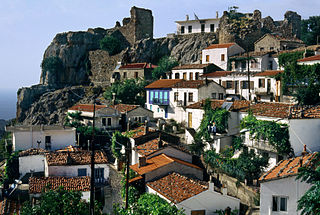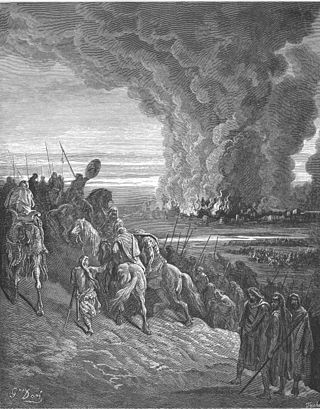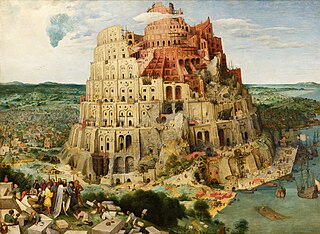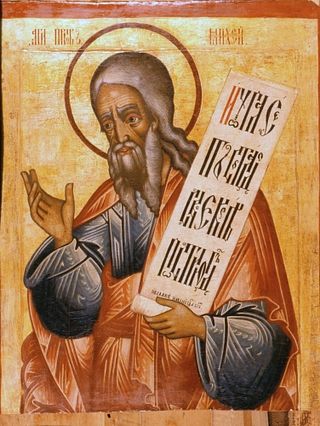Related Research Articles

The Book of Nehemiah in the Hebrew Bible, largely takes the form of a first-person memoir by Nehemiah, a Jew who is a high official at the Persian court, concerning the rebuilding of the walls of Jerusalem after the Babylonian exile and the dedication of the city and its people to God's laws (Torah).

Nineveh, also known in early modern times as Kouyunjik, was an ancient Assyrian city of Upper Mesopotamia, located in the modern-day city of Mosul in northern Iraq. It is located on the eastern bank of the Tigris River and was the capital and largest city of the Neo-Assyrian Empire, as well as the largest city in the world for several decades. Today, it is a common name for the half of Mosul that lies on the eastern bank of the Tigris, and the country's Nineveh Governorate takes its name from it.

Bethel was an ancient Israelite city and sacred space that is frequently mentioned in the Hebrew Bible.

Sheba is an ancient kingdom mentioned in the Hebrew Bible and the Quran. It particularly features in the tradition of Orthodox Tewahedo in today's Yemen and is also asserted as the home of the Queen of Sheba, who is left unnamed in Jewish texts, but is known as Makeda in Ethiopian texts and as Bilqīs in Arabic texts. According to the Jewish historian Josephus, Sheba was the home of Princess Tharbis, who is said to have been the wife of Moses before he married Zipporah.

Samothrace is a Greek island in the northern Aegean Sea. It is a municipality within the Evros regional unit of Thrace. The island is 17 km (11 mi) long, 178 km2 (69 sq mi) in size and has a population of 2,596. Its main industries are fishing and tourism. Resources on the island include granite and basalt. Samothrace is one of the most rugged Greek islands, with Mt Saos and its highest peak, Fengari, rising to 1,611 m (5,285 ft). The Winged Victory of Samothrace statue, which is now displayed at the Louvre in Paris, originates from the island.

The Monasterboice ruins are the remains of an early Christian monastic settlement in County Louth in Ireland, north of Drogheda. The ruins are a national monument of Ireland and also give their name to the local village and to a civil parish of the same name.

The Ai was a city in Canaan, mentioned in the Hebrew Bible. According to the Book of Joshua, it was conquered by the Israelites, headed by Joshua, during their conquest of Canaan.

According to the Deuteronomistic history in the Hebrew Bible, a United Monarchy or United Kingdom of Israel existed under the reigns of Saul, Eshbaal, David, and Solomon, encompassing the territories of both the later kingdoms of Judah and Israel.
Hormah, also known by its Canaanite name Zephath, is an unidentified city mentioned in the Hebrew Bible in relation to several conflicts between the migrant Israelite people seeking to enter the Promised Land and the Amalekites and the Canaanites who dwelt at that time in southern Canaan.
Dedan has several different meanings in the Hebrew Bible. Dedan was an oasis and city-state of north-western Arabia. The people of Dedan are called Dedanim or Dedanites. Dedan is also the name of the son of Raamah and the son of Jokshan.

Alūksne is a town on the shores of Lake Alūksne in northeastern Latvia near the borders with Estonia and Russia. It is the seat of the Alūksne municipality. Alūksne is the highest elevated Latvian city, located in East Vidzeme Upland at 217 m above sea level. The high elevation of the city affects the social and physical arrangement of the place.

The Tower of Babel was the subject of three paintings by Pieter Bruegel the Elder. The first, a miniature painted on ivory, was painted while Bruegel was in Rome and is now lost. The two surviving paintings, often distinguished by the prefix "Great" and "Little", are in the Kunsthistorisches Museum, Vienna and the Museum Boijmans Van Beuningen in Rotterdam respectively. Both are oil paintings on wood panels.

According to the Hebrew Bible, Micah, also known as Micheas, was a prophet in Judaism and is the author of the Book of Micah. He is considered one of the Twelve Minor Prophets of the Hebrew Bible and was a contemporary of the prophets Isaiah, Amos and Hosea. Micah was from Moresheth-Gath, in southwest Judah. He prophesied during the reigns of kings Jotham, Ahaz, and Hezekiah of Judah.

Babylon was an ancient city located on the lower Euphrates river in southern Mesopotamia, within modern-day Hillah, Iraq, about 85 kilometers south of modern day Baghdad. Babylon functioned as the main cultural and political centre of the Akkadian-speaking region of Babylonia. Its rulers established two important empires in antiquity, the 19th–16th century BC Old Babylonian Empire, and the 7th–6th century BC Neo-Babylonian Empire. Babylon was also used as a regional capital of other empires, such as the Achaemenid Empire. Babylon was one of the most important urban centres of the ancient Near East, until its decline during the Hellenistic period. Nearby ancient sites are Kish, Borsippa, Dilbat, and Kutha.

École biblique et archéologique française de Jérusalem, commonly known as École Biblique, is a French academic establishment in Jerusalem specializing in archaeology and Biblical exegesis. It is housed by the Saint-Étienne priory.

The Monastery of Saint Translators is an Armenian monastery, founded in the 4th century. It is located north of Dashkasan, in Azerbaijan.

The Lachish reliefs are a set of Assyrian palace reliefs narrating the story of the Assyrian victory over the kingdom of Judah during the siege of Lachish in 701 BCE. Carved between 700 and 681 BCE, as a decoration of the South-West Palace of Sennacherib in Nineveh, the relief is today in the British Museum in London, and was included as item 21 in the BBC Radio 4 series A History of the World in 100 Objects by the museum's former director Neil MacGregor. The palace room, where the relief was discovered in 1845–1847, was fully covered with the "Lachish relief" and was 12 metres (39 ft) wide and 5.10 metres (16.7 ft) long. The Lion Hunt of Ashurbanipal sequence was found in the same palace.

Harran al-'Awamid is a town in southern Syria, administratively part of the Rif Dimashq Governorate, located southeast of Damascus. It is situated on a plain that stretches to the marshes of Bahrat al-Qibliyah along the boundary of the fertile Ghouta region to the west, to the north of the Hauran. Nearby localities include al-Kafrayn and Judaydat al-Khas to the south, al-Atibeh to the northeast, al-Abadah and al-Qisa to the north, al-Ahmadiyah to the northwest, Sakka to the west and Ghasulah and al-Ghizlaniyah to the southwest.

Isaiah 58 is the fifty-eighth chapter of the Book of Isaiah in the Hebrew Bible or the Old Testament of the Christian Bible. This book contains the prophecies attributed to the prophet Isaiah, and is one of the Books of the Prophets. Chapters 56-66 are often referred to as Trito-Isaiah. This chapter contains a proclamation regarding "fasting that pleases God".

Jeremiah 38 is the thirty-eighth chapter of the Book of Jeremiah in the Hebrew Bible or the Old Testament of the Christian Bible. It is numbered as Jeremiah 45 in the Septuagint. This book contains prophecies attributed to the prophet Jeremiah, and is one of the Books of the Prophets. This chapter is part of a narrative section consisting of chapters 37 to 44. Chapter 38 records the petition from the royal officials to punish Jeremiah, his confinement in the dungeon or cistern and his rescue from there, although he remains in captivity, a secret conversation between Jeremiah and King Zedekiah, and the inquiry of Jeremiah by the king's officials.
References
- ↑ International Standard Bible Encyclopedia, "Iyim" (1915).
- The New Unger's Bible Dictionary. Originally published by Moody Press of Chicago, Illinois. Copyright (c) 1988